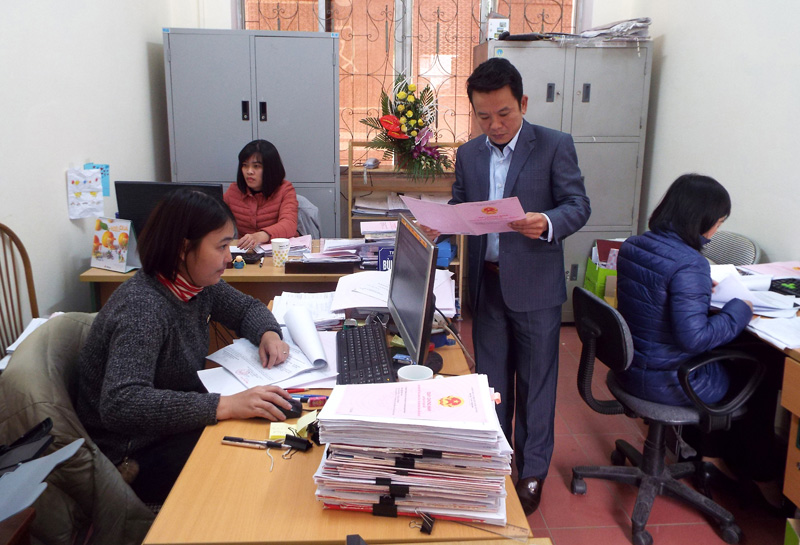
(HBO) – Hoa Binh province is working to facilitate businesses’ access to land that is one of the 10 sub-indexes to measure the Provincial Competitiveness Index (PCI) – the rankings on which Hoa Binh fell six places from 2015 to the 52nd position among the country’s 63 provinces and cities in 2016.

The
land registration office of Hoa Binh was put into operation, ensuring the
consistency in land management among localities and providing land-related information
for the public.
The province’s land access sub-index always stood at low
level, ranking 42nd, 15th, 30th and 51st from 2011 to 2015 respectively. It was
at the 41st position in 2016, up 11 places from 2015.
While 25 percent of businesses with land use
demand nationwide worry about cumbersome procedures, this rate is 43 percent in
Hoa Binh. Within two years, 64 percent of local firms encountered difficulties
in making land procedures. Up to 44 percent of companies have not had land use
right certificates due to red tape or fear of obstacles created by public
employees.
According to a survey conducted by the Vietnam
Chamber of Commerce and Industry (VCCI), local businesses find it relatively
difficult to get access to land and production ground. They are facing a number
of hindrances to land access and expansion of production and business ground.
There remain many shortcomings in compensation and site clearance mechanisms.
To address those weaknesses and facilitate land
access, the provincial People’s Committee issued in 2017 a plan on improving
the business environment and competitiveness of Hoa Binh with a vision until
2020. It assigned the provincial Department of Natural Resources and
Environment to coordinate with other agencies, sectors and local district-level
administrations to step up administrative reforms. They have been implementing
concrete solutions such as overhauling land-related administrative procedures,
especially formalities for granting land use right certificates, and facilitating
enterprises’ access to land and planning information.
The implementation of the business climate
improvement plan at the provincial Department of Natural Resources and
Environment show that criteria in the land access sub-index has been improved.
The department publicized the province’s
resolution on land use planning until 2020, land use plans and planning until
2020 of district-level localities, and administrative procedures relevant to
natural resources and the environment.
It has also worked with district-level People’s
Committees to examine and assess the land management and use at projects so as
to propose the settlement of violations and poor-performing projects./.
According to data from the Hoa Binh Provincial Party Committee, the industrial production index for the first six months of 2025 is estimated to have increased by 20% compared to the same period last year. This marks the highest year-on-year growth rate for this period since 2020.
In the first six months of 2025, Hoa Binh province’s export turnover was estimated at 1.145 billion USD, marking an 18.11% increase compared to the same period in 2024. Import turnover was estimated at $ 804 million, a 17.15% increase, which helped the province maintain a positive trade balance.
The lives of the ethnic minority farmers in Tan Lac district have gradually improved thanks to the new directions in agricultural production. This is a testament to the collective strength fostered through the professional associations and groups implemented by various levels of the district’s Farmers’ Union.
With the motto the "product quality comes first,” after nearly one year of establishment and operation, Muong village’s Clean Food Agricultural and Commercial Cooperative, located in Cau Hamlet, Hung Son Commune (Kim Boi district), has launched reputable, high-quality agricultural products to the market that are well-received by consumers. The products such as Muong village’s pork sausage, salt-cured chicken, and salt-cured pork hocks have gradually carved out a place in the market and they are on the path to obtaining the OCOP certification.
In the past, the phrase "bumper harvest, rock-bottom prices" was a familiar refrain for Vietnamese farmers engaged in fragmented, small-scale agriculture. But today, a new spirit is emerging across rural areas of Hoa Binh province - one of collaboration, organisation, and collective economic models that provide a stable foundation for production.
Maintaining growing area codes and packing facility codes in accordance with regulations is a mandatory requirement for agricultural products to be eligible for export. Recently, the Department of Agriculture and Environment of Hoa Binh province has intensified technical supervision of designated farming areas and packing facilities to safeguard the "green passport" that enables its products to access international markets.



